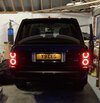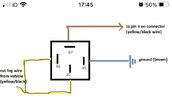Isoproturon
New Member
I am converting a 2008 Range Rover from filament rear lights to the later LED clusters. I have run into the following issue and would appreciate some help.
The original lights used a 5W supply to provide the tail lights, increasing to 21w when the fog light switch was pressed. It is a standard 12V system.
On the new lights the tail lights (outer rings) and fog lights (centre of the lower ring) are separate. There is a wire for fog lights and one for tail lights. When switching the tail lights on, they come on but the centre section which is only meant to illuminate as a fog light (when switch pressed) comes on in a low power mode. It gets brighter when the fog switch is on.
I would like to ensure this centre section only comes on when the fog light is switched on, as it is not needed due to the fact it has separate tail lights.
Reading up, it appears that a simple relay circuit could solve this but I am under the impression it needs a diode and resistor adding.
Not quite sure where to start, working out what specification and what components are also needed.
If anyone could help I would be very pleased!
The original lights used a 5W supply to provide the tail lights, increasing to 21w when the fog light switch was pressed. It is a standard 12V system.
On the new lights the tail lights (outer rings) and fog lights (centre of the lower ring) are separate. There is a wire for fog lights and one for tail lights. When switching the tail lights on, they come on but the centre section which is only meant to illuminate as a fog light (when switch pressed) comes on in a low power mode. It gets brighter when the fog switch is on.
I would like to ensure this centre section only comes on when the fog light is switched on, as it is not needed due to the fact it has separate tail lights.
Reading up, it appears that a simple relay circuit could solve this but I am under the impression it needs a diode and resistor adding.
Not quite sure where to start, working out what specification and what components are also needed.
If anyone could help I would be very pleased!



